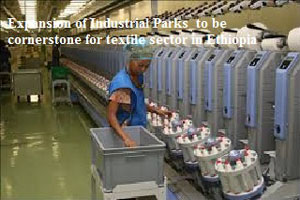
Expansion of Industrial Parks to be cornerstone for textile sector in Ethiopia
YarnsandFibers News Bureau 2016-08-18 12:00:00 – AfricaEthiopia working tirelessly to boost various industries in the second Growth and Transformation Plan that will support the journey to industrialization. Also as the country's climate is suitable and very supportive for animal fiber and cotton production which are significant ingredients for the textile industry. The country realizing the benefits has begun investing in the textile industry. On the other hand, the plenty of young human resource will assist every engagement in the sector.
Recently, in addition to the Bole Industry Village, similar industry village has been marked in Hawassa. Furthermore, simultaneously the construction of extra industrial villages (parks) is underway throughout the country.
Hawassa Industrial Park (HIP) construction involved cost to more than 5 billion Birr. The expansion of such huge industrial park is the indication of the nation's progress to the industrialization. It is also one of the parks to be inaugurated soon and operate for textile and apparel sector. Development in the sector also necessitates the importation of modern technological equipment and transfer of knowledge so as to strengthen the production and productivity. Moreover it paves the way for experience sharing and training from the world textile partners.
If the country could not compete on the world market, it would be a great loss. Because competing on the international market is not a preference rather it is an obligation, according to Fasil Tadesse, Managing Director of Kebire Enterprise and African Cotton, Garment and Textiles Federation Board and Ethiopian Textile Industries Associations President.
According to him, expanding industry villages has a number of benefits including attracting various companies, involving competent national organizations and accelerating the sector's business throughout the country and the world. Nowadays, the nation is on the right track through direct foreign exchange. The world giant garment industry companies are coming to Ethiopia. Therefore, the coming of these companies might be followed by other small but critical companies that are producing string, button and other similar bolstering textile materials. This could help the nation to reduce the import cost by producing these materials at home.
On the other hand, the situation facilitates the opportunity for technological transformation. Indigenous garment fabrics will share important experience from their foreign business partners. The training opportunity will also be managed. Other foreign based Ethiopian garment industries also will come back to use the opportunity. This shows the significance of the expansion of industrial zones.
Fasil believes that simply constructing industrial villages could not be a change; it needs the involvement of sector factories and companies. Especially, the participation of indigenous textile companies will play a significant role in building nation's capacity through enabling national producers to look for their nation brand.
On the other hand, the participation of the indigenous factories is important scheme to safe the sector from the influence of fluctuation of foreign companies. Here, the role of the government is vital to encourage national companies to engage in the sphere whether the foreign companies are engaged or not.
Noticing the experience of Bangladesh's textile firm, Fasil explained that over 80 percent of companies in the Bangladesh textile industry village are national companies. These could be happen for the reason that their government has been making notable encouragements for national companies by facilitating financial and material subsidies. It also provided useful training for the companies. Ethiopian government should learn from this.
Fasil also noticed that in Ethiopia there are two main problems in the garment industry sphere. The first one is that most of the individuals who have the training and knowledge of the sector have no the capital to spent for it. Moreover, the main problem is lack of mediation to coordinate these crucial business partners to work together so that they would be profitable in the textile industry.
The government should also facilitate the assistance of finance to the middle capital industries. On the other hand, the joining of foreign companies in the Ethiopian textile industry will be the bolstering companion to the indigenous companies. The expansion of industry villages is one of the most significant measures in the development of the sector. The accumulation of these measurements may reduce the problems related to the textile sector.
The other problem in the Ethiopian textile industry is lower capacity of native factories and companies on investment. Therefore, to reduce such chains of problems the Ethiopian Textiles Industries Association is doing its level best through building the capacity of native companies and enabling them to be competent on market. It is also facilitating market opportunities. The association is also working with stakeholders to address problems that are needed the support of the government and other partners.
The development of industrial parks is a cornerstone for the development of manufacturing sector for the implementation of Ethiopia’s vision to become middle income country and top light manufacturing hub by 2025.
Market Intelligence
Ask for free sample Report

experience
Customer Base
dedicated team
Countries Served Worldwide









